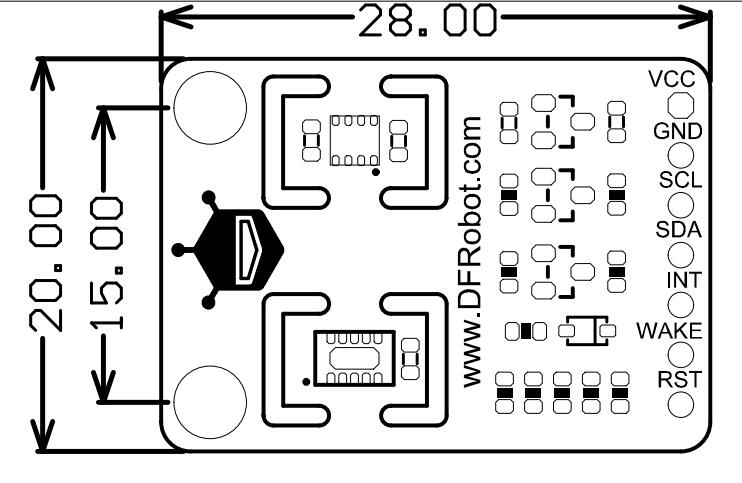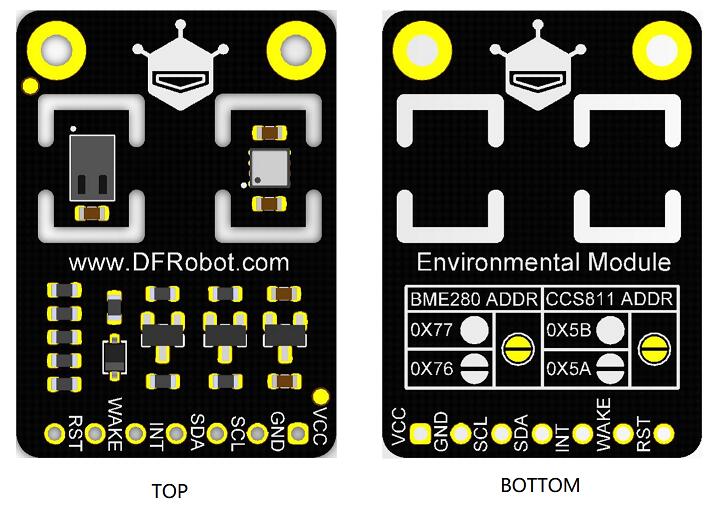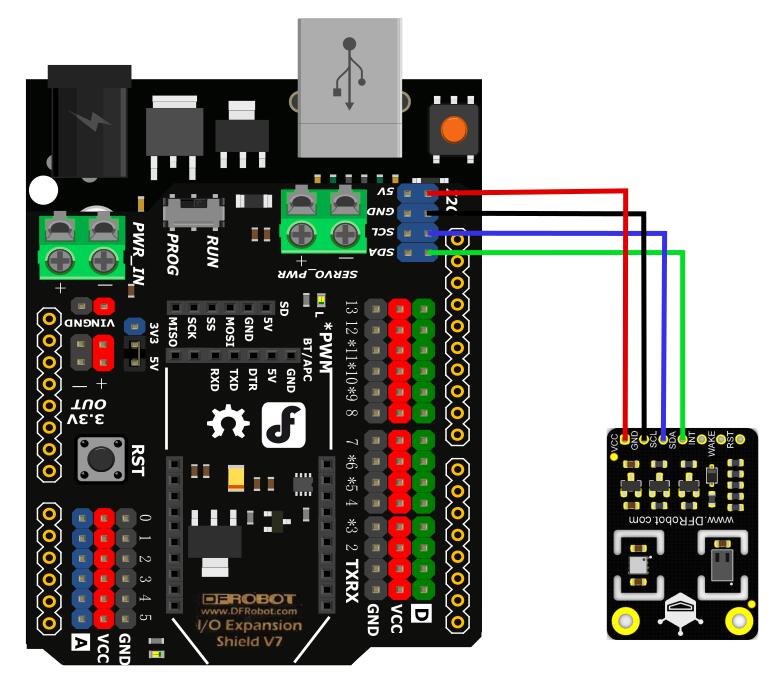简介
做简易的天气站,这一款传感器就够了!这是一款精准的环境传感器,采用CCS811+BME280芯片组合,BME280可对CCS811进行温湿度补偿,IIC接口,可以快速的测出温度、湿度、气压、海拔、TVOC和eCO2。
CCS811使用AMS独有的微热板技术,相比传统的气体传感器,功耗更低、预热时间更短、体积更小。内部集成ADC和MCU,可以对数据进行采集、计算,并且通过I2C返回数据。
BME280是一款集成温度、湿度、气压,三位一体的环境传感器。具有高精度,多功能,小尺寸等特点。温度误差为0.5℃,湿度误差为2%RH,气压测量在整个温区非常稳定的,偏置温度系数±1.5 pa/k,当温度变化时,1摄氏度的温度变化导致的误差仅在12.6厘米。
⚠注意:CCS811对I2C进行了时钟延展,有些控制器不支持时钟延展,例如树莓派。
二氧化碳浓度参考
| 二氧化碳浓度(ppm) | 人体反应 |
|---|---|
| <500 | 正常 |
| 500-1000 | 感到空气污浊 |
| 1000-2500 | 感到困倦 |
| 2500-5000 | 对健康不利 |
| 大于5000 | 有中毒危险 |
TVOC浓度参考
| TVOC浓度(ppb) | 人体反应 |
|---|---|
| <50 | 正常 |
| 50-750 | 可能会急躁不安和不舒服 |
| 750-6000 | 可能会急躁不安、不舒服和头疼 |
| >6000 | 头痛和其他神经问题 |
应用场景
- 环境检测
- 空气净化器
- 家庭控制器
- 新风系统
- 天气预知
技术规格
- 供电电压:3.3V~5.5 V
- 工作电流:<20mA
CCS811参数: - 预热时间:<15s
- IIC地址:0x5A(默认)/0X5B
- 工作温度范围:-40℃~85℃
- 工作湿度范围:10%RH~95%RH
- eCO2测量范围:400ppm~8000ppm
- TVOC测量范围:0ppb~1100ppb
BME280参数: - IIC地址:0x76(默认)/0X77
- 工作温度:-40℃~85℃
- 温度测量范围:-40℃~+85℃,分辨率0.1℃,误差±0.5℃
- 湿度检测范围:0~100%RH,分辨率0.1%RH,误差±2%RH
- 压力检测范围:300~1100hPa
引脚说明
| 序号 | 丝印 | 功能描述 |
|---|---|---|
| 1 | VCC | 电源正极 |
| 2 | GND | 电源负极 |
| 3 | SCL | I2C时钟线 |
| 4 | SDA | I2C数据线 |
| 5 | INT | CCS811中断引脚:低电平中断 |
| 6 | WAKE | CCS811模式选择引脚:低电平唤醒/高电平睡眠 |
| 7 | RST | CCS811复位引脚:低电平复位 |
使用教程
该产品预热时间短,在上电后很短时间就能有准确的读数,在设置环境基线后能够更快的有准确读数(下面会讲基线获取和设置方法)
⚠**注意:**数据手册建议在第一次使用传感器时,先运行48小时
准备
- 硬件
- 1 x Arduino UNO控制板
- 1 x 多功能环境传感器-CCS811+BME280
- 若干 杜邦线
- 软件
- Arduino IDE, 点击下载Arduino IDE
- CCS811库文件和示例程序
- BME280库文件和示例程序
关于如何安装库文件,点击链接
- 主要API接口函数列表
/**
* @功能 判断是否可以读取数据
* @返回 可以读取时为true,否则为false
*/
bool checkDataReady();
/**
* @功能 设置环境参数
* @参数 温度输入温度值,单位:摄氏度,范围(-40-85℃)
* @参数 湿度输入湿度值,单位:%RH,范围(0-100%RH)
*/
void setInTemHum(float temperature, float humidity);
/**
* @功能 设置测量周期和中断
* @参数 cycle: eClosed :空闲(在此模式下禁用测量)
* eCycle_1s :每秒进行一次测量
* eCycle_10s :每10秒进行一次测量
* eCycle_60s :每60秒进行一次测量
* eCycle_250ms :每250ms进行一次测量
* @参数 thresh: 0:禁止报警中断
* 1:启用报警中断
* @参数 interrupt: 0:禁止采集中断
* 1:启用采集中断
*/
void setMeasurementMode(eCycle_t mode, uint8_t thresh = 0, uint8_t interrupt = 0, );
/**
* @功能 获取当前的二氧化碳浓度
* @返回 当前二氧化碳浓度,单位:ppm
*/
uint16_t getCO2PPM();
/**
* @功能 获取当前的TVOC浓度
* @返回 返回当前的TVOC浓度,单位:ppb
*/
uint16_t getTVOCPPB();
/**
*@功能 获取当前的基线值
*@返回 当前基线值的十六进制数
*/
uint16_t readBaseLine();
/**
*@功能 将基线编值写入寄存器
*@参数 从getBaseLine.ino获取一个十六进制数
*/
void writeBaseLine(uint16_t baseLine);
接线图
样例代码1 - 获取基线
为什么要获取基线?
因为之后你可以写入获取的基线,这样可以让传感器预热后立即显示空气质量,否则在污染空气中启动时需要非常久的时间才有正确读数
数据手册对基线校准的建议:在运行传感器的第一周,建议每24小时保存一个新的基线,运行1周后,可以每1-28天保存一次
⚠**特别注意:**请放在空气清新的环境中(20分钟以上)获取基线,不同传感器、不同测量周期基线不同
/*!
* @file getBaseLine.ino
* @brief Put the module in clear air and work a few minutes, wait for baseline doing not change
* @n Experiment phenomenon: get
*
* @copyright Copyright (c) 2010 DFRobot Co.Ltd (http://www.dfrobot.com)
* @licence The MIT License (MIT)
* @author [LuoYufeng](yufeng.luo@dfrobot.com)
* @version V0.1
* @date 2019-07-19
* @get from https://www.dfrobot.com
* @url https://github.com/DFRobot/DFRobot_CCS811
*/
#include "DFRobot_CCS811.h"
/*
* IIC address default 0x5A, the address becomes 0x5B if the ADDR_SEL is soldered.
*/
//DFRobot_CCS811 CCS811(&Wire, /*IIC_ADDRESS=*/0x5A);
DFRobot_CCS811 CCS811;
void setup(void)
{
Serial.begin(115200);
/*Wait for the chip to be initialized completely, and then exit*/
while(CCS811.begin() != 0){
Serial.println("failed to init chip, please check if the chip connection is fine");
delay(1000);
}
}
void loop() {
if(CCS811.checkDataReady() == true){
/*!
* @brief Set baseline
* @return baseline in clear air
*/
Serial.println(CCS811.readBaseLine(), HEX);
} else {
Serial.println("Data is not ready!");
}
//delay cannot be less than measurement cycle
delay(1000);
}
结果
经过一段时间后基线稳定
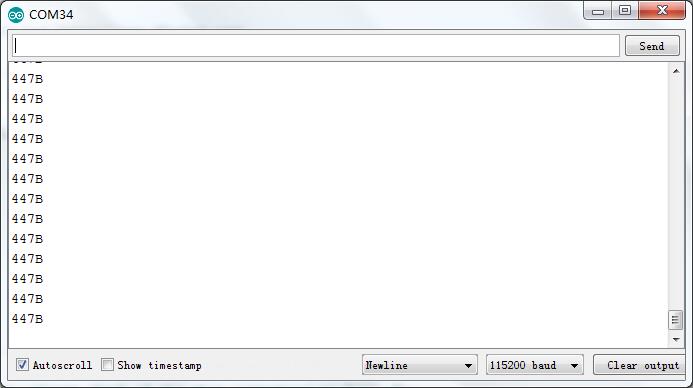
样例代码2 - 获取数据
请将获取到的基线值填入到sensor.writeBaseLine();这个函数中。如果您不设置基线请在示例程序中将这个函数屏蔽,传感器将自动校准基线,但是这个过程非常缓慢。
上传到UNO后打开串口监视器我们可以的看到CO2和TVOC浓度。
/*!
* @file readData.ino
* @brief Read the concentration of carbon dioxide and TVOC
* @n Experiment phenomenon: read data every 0.5s, and print it out on serial port.
*
* @copyright Copyright (c) 2010 DFRobot Co.Ltd (http://www.dfrobot.com)
* @licence The MIT License (MIT)
* @author [LuoYufeng](yufeng.luo@dfrobot.com)
* @version V0.1
* @date 2019-07-19
* @get from https://www.dfrobot.com
* @url https://github.com/DFRobot/DFRobot_CCS811
*/
#include "DFRobot_CCS811.h"
/*
* IIC address default 0x5A, the address becomes 0x5B if the ADDR_SEL is soldered.
*/
//DFRobot_CCS811 CCS811(&Wire, /*IIC_ADDRESS=*/0x5A);
DFRobot_CCS811 CCS811;
void setup(void)
{
Serial.begin(115200);
/*Wait for the chip to be initialized completely, and then exit*/
while(CCS811.begin() != 0){
Serial.println("failed to init chip, please check if the chip connection is fine");
delay(1000);
}
}
void loop() {
if(CCS811.checkDataReady() == true){
Serial.print("CO2: ");
Serial.print(CCS811.getCO2PPM());
Serial.print("ppm, TVOC: ");
Serial.print(CCS811.getTVOCPPB());
Serial.println("ppb");
} else {
Serial.println("Data is not ready!");
}
/*!
* @brief Set baseline
* @param get from getBaseline.ino
*/
CCS811.writeBaseLine(0x447B);
//delay cannot be less than measurement cycle
delay(1000);
}
结果
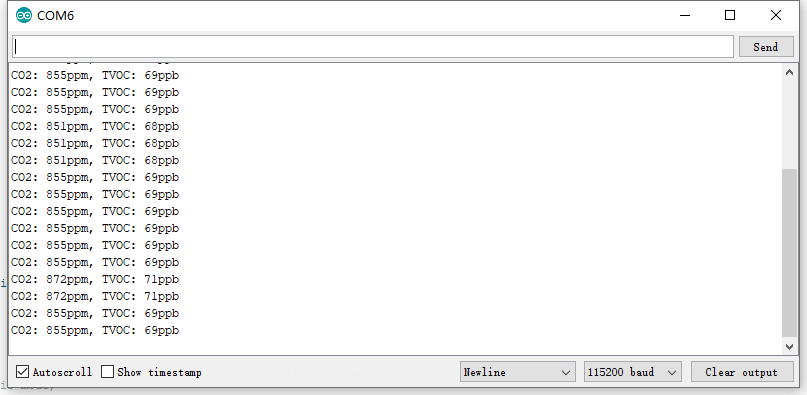
样例代码3 - 浓度报警
请将获取到的基线值填入到sensor.writeBaseLine();这个函数中。如果您不设置基线请在示例程序中将这个函数屏蔽,传感器将自动校准基线,但是这个过程非常缓慢。
当CO2浓度从当前范围(低、中、高)移动到另一个范围(超过50ppm),则产生中断,并在打印当前CO2值。
本样例需要将传感器的INT引脚连接到主控板相应的中断引脚(样例选用的UNO中断引脚D2)。
| AVR系列中断引脚与中断号 | |||||||
|---|---|---|---|---|---|---|---|
| Uno,Nano,Mini 其他328主板 | 中断引脚 | D2 | D3 | ||||
| Uno,Nano,Mini 其他328主板 | 中断号 | 0 | 1 | ||||
| Mega2560 | 中断引脚 | D2 | D3 | D21 | D20 | D19 | D18 |
| Mega2560 | 中断号 | 0 | 1 | 2 | 3 | 4 | 5 |
| Leonardo,其他32u4主板 | 中断引脚 | D3 | D2 | D0 | D1 | D7 | |
| Leonardo,其他32u4主板 | 中断号 | 0 | 1 | 2 | 3 | 4 |
/*!
* @file setInterrupt.ino
* @brief Set interrupt parameter, when CO2 concentration range changes, get an interrupt
* @n Experiment phenomenon: read data every 1s, and print it out on serial port.
*
* @copyright Copyright (c) 2010 DFRobot Co.Ltd (http://www.dfrobot.com)
* @licence The MIT License (MIT)
* @author [LuoYufeng](yufeng.luo@dfrobot.com)
* @version V1.0
* @date 2019-07-13
* @get from https://www.dfrobot.com
* @url https://github.com/DFRobot/DFRobot_Sensor
*/
#include "DFRobot_CCS811.h"
volatile int8_t GPIO1TRIG = 0;
/*
* IIC address default 0x5A, the address becomes 0x5B if the ADDR_SEL is soldered.
*/
//DFRobot_CCS811 CCS811(&Wire, /*IIC_ADDRESS=*/0x5A);
DFRobot_CCS811 CCS811;
void setup(void)
{
Serial.begin(115200);
/*wait for the chip to be initialized completely, and then exit*/
while(CCS811.begin() != 0){
Serial.println("failed to init chip, please check if the chip connection is fine");
delay(1000);
}
attachInterrupt(0, interrupt, RISING);
/**
* @brief Measurement parameter configuration
* @param mode:in typedef enum{
* eClosed, //Idle (Measurements are disabled in this mode)
* eCycle_1s, //Constant power mode, IAQ measurement every second
* eCycle_10s, //Pulse heating mode IAQ measurement every 10 seconds
* eCycle_60s, //Low power pulse heating mode IAQ measurement every 60 seconds
* eCycle_250ms //Constant power mode, sensor measurement every 250ms 1xx: Reserved modes (For future use)
* }eCycle_t;
* @param thresh:0 for Interrupt mode operates normally; 1 for interrupt mode only asserts the nINT signal (driven low) if the new
* @param interrupt:0 for Interrupt generation is disabled; 1 for the nINT signal is asserted (driven low) when a new sample is ready in
*/
CCS811.setMeasurementMode(CCS811.eCycle_250ms, 1, 1);
/**
* @brief Set interrupt thresholds
* @param lowToMed: interrupt triggered value in range low to middle
* @param medToHigh: interrupt triggered value in range middle to high
*/
CCS811.setThresholds(1500,2500);
}
void loop() {
if(GPIO1TRIG == 1){
Serial.println("CO2 range has changed");
Serial.print("CO2: ");
Serial.print(CCS811.getCO2PPM());
Serial.print("ppm, TVOC: ");
Serial.print(CCS811.getTVOCPPB());
Serial.println("ppb");
delay(1000);
}
GPIO1TRIG = 0;
Serial.print("CO2: ");
Serial.print(CCS811.getCO2PPM());
Serial.print("ppm, TVOC: ");
Serial.print(CCS811.getTVOCPPB());
Serial.println("ppb");
CCS811.writeBaseLine(0x447B);
delay(1000);
}
void interrupt(){
GPIO1TRIG = 1;
}
结果
当对传感器呼气,CO2浓度范围发生了变化,产生了一次中断;当气体浓度降下来时,也产生了一次中断
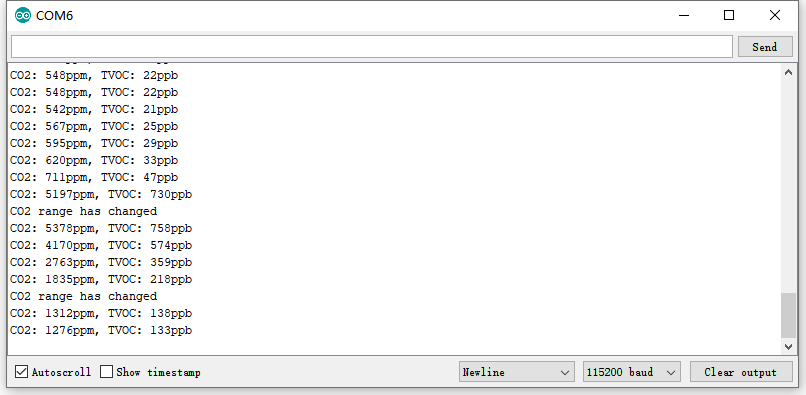
样例代码4 - BME280获取数据
注意:使用前请注意程序中BME280的IIC地址,如果硬件IIC地址和程序中IIC地址不同会造成芯片初始化失败。
运行后将会看到串口打印相关数据
/*!
* raed_data_i2c.ino
*
* Download this demo to test read data from bme280, connect sensor through IIC interface
* Data will print on your serial monitor
*
* Copyright [DFRobot](http://www.dfrobot.com), 2016
* Copyright GNU Lesser General Public License
*
* version V1.0
* date 12/03/2019
*/
#include "DFRobot_BME280.h"
#include "Wire.h"
typedef DFRobot_BME280_IIC BME; // ******** use abbreviations instead of full names ********
BME bme(&Wire, 0x76); // select TwoWire peripheral and set sensor address
#define SEA_LEVEL_PRESSURE 1015.0f
// show last sensor operate status
void printLastOperateStatus(BME::eStatus_t eStatus)
{
switch(eStatus) {
case BME::eStatusOK: Serial.println("everything ok"); break;
case BME::eStatusErr: Serial.println("unknow error"); break;
case BME::eStatusErrDeviceNotDetected: Serial.println("device not detected"); break;
case BME::eStatusErrParameter: Serial.println("parameter error"); break;
default: Serial.println("unknow status"); break;
}
}
void setup()
{
Serial.begin(115200);
bme.reset();
Serial.println("bme read data test");
while(bme.begin() != BME::eStatusOK) {
Serial.println("bme begin faild");
printLastOperateStatus(bme.lastOperateStatus);
delay(2000);
}
Serial.println("bme begin success");
delay(100);
}
void loop()
{
float temp = bme.getTemperature();
uint32_t press = bme.getPressure();
float alti = bme.calAltitude(SEA_LEVEL_PRESSURE, press);
float humi = bme.getHumidity();
Serial.println();
Serial.println("======== start print ========");
Serial.print("temperature (unit Celsius): "); Serial.println(temp);
Serial.print("pressure (unit pa): "); Serial.println(press);
Serial.print("altitude (unit meter): "); Serial.println(alti);
Serial.print("humidity (unit percent): "); Serial.println(humi);
Serial.println("======== end print ========");
delay(1000);
}
结果
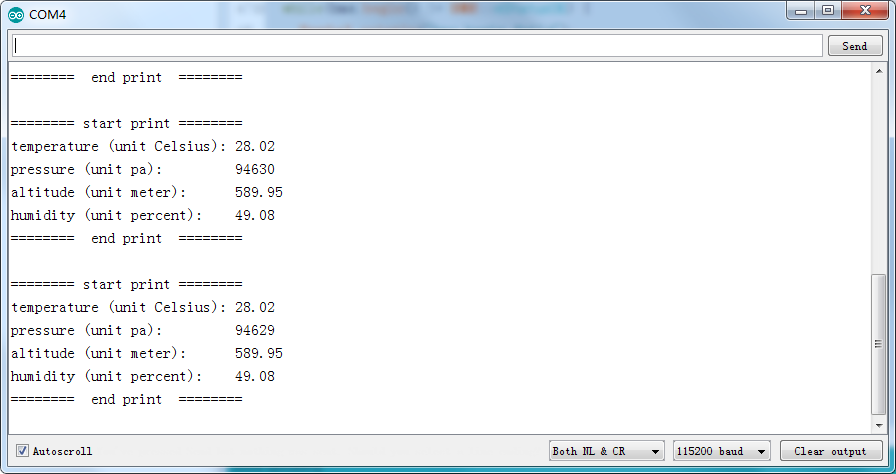
常见问题
Q:为什么我初始化传感器失败打印:device not detected
A:请检查代码中的IIC地址是否与传感器地址相同
更多问题及有趣的应用,可以 访问论坛 进行查阅或发帖。
